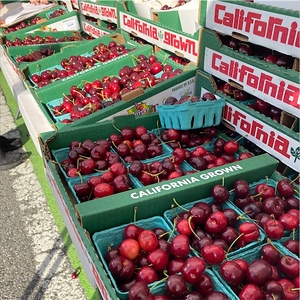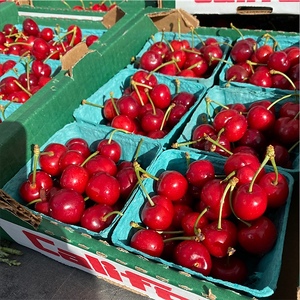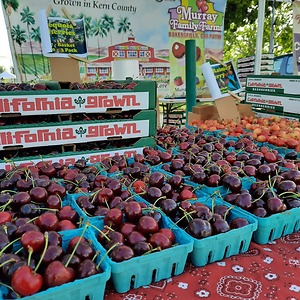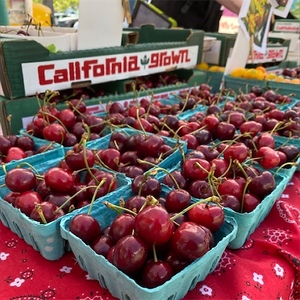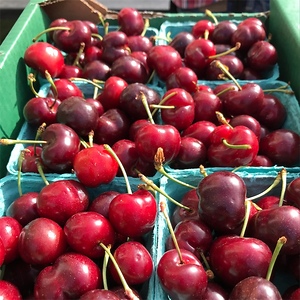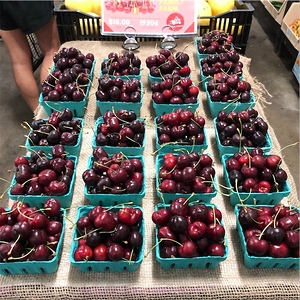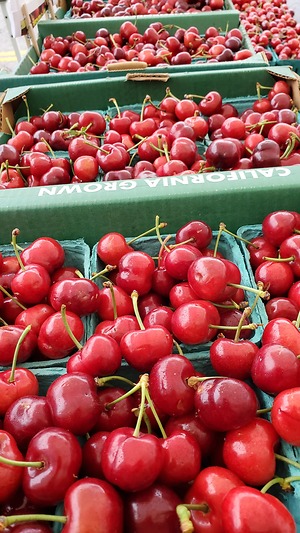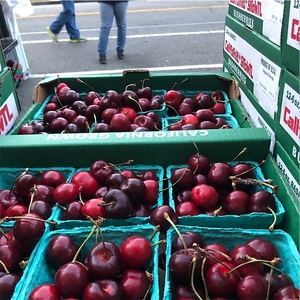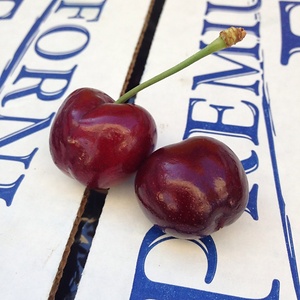


SEQUOIA® Cherries
Estimated Inventory, lb : 0
This item was last sold on : 05/27/24
Description/Taste
Sequoia® cherries are a small to medium varietal, averaging around two centimeters in diameter, and have a uniform ovate, round, to cordate shape. The fruits are also attached to long, slender, and pliable, yellow-green stems that reach up to five centimeters in length. The skin is semi-thick, glossy, taut, and smooth, ranging in color from crimson, dark red, to purple, almost black. Underneath the surface, the flesh is plump, aqueous, crisp, and firm with low fibers, creating a tender consistency. The flesh also showcases brilliant pink, burgundy, and dark red, variegated hues, encasing a semi-freestone pit that is loosely adhered in the center of the fruit. Sequoia® cherries contain 16 to 22 Brix, a sugar level measurement within the flesh, contributing to a rich and complex, sweet-tart flavor.
Seasons/Availability
Sequoia® cherries are available in the mid to late spring in California. In Washington state, the cherries are available in the late spring to early summer. In the southern hemisphere, Sequoia® cherries are in season in November.
Current Facts
Sequoia® cherries, botanically classified as Prunus avium, are a rare grouping of hybrid varieties belonging to the Rosaceae family. The name Sequoia® is a general descriptor used to encompass three different types of cherries that share a similar flavor profile, appearance, and ripening time. The most well-known variety of the three is the Glenred, also known under the US Plant Patent #12859. Glenred cherries ripen and are sold in commercial markets first, followed by the other cultivars Glen Rock and Glenoia. Sequoia® cherries are proprietary varieties specifically designed with low-chill requirements to grow well in temperate climates, especially in California, to meet a market need for early-season cherries. The cherries often appear in markets as early as April and are celebrated for their sweet-tart flavor, size, and juicy nature. Sequoia® cherries are also hardy and able to withstand transport, exported to Asia, where the fruits can be sold at luxury prices.
Nutritional Value
Sequoia® cherries are a good source of potassium to balance fluid levels within the body and fiber to regulate the digestive tract. The fruits also contain antioxidants to reduce inflammation, vitamins A and C to strengthen the immune system, and provide lower amounts of copper, iron, calcium, and manganese.
Applications
Sequoia® cherries have a sweet-tart flavor well suited for fresh and cooked preparations. The fruits can be consumed straight, out of hand, discarding the pit, or they can be chopped into coleslaws, blended into smoothies, mixed into fruit and green salads, or diced into salsa. The cherries can also be simmered into barbeque and sweet sauces, typically served over roasted meats for a savory-sweet combination, or they can be cooked into compotes, jams, and jellies. In addition to sauces, Sequoia® cherries have a natural sweetness and sturdy texture ideal for baked goods, including cobblers, crisps, muffins, bars, pies, and scones. The cherries can also be blended into ice cream or infused into syrups for desserts, cocktails, and lemonade. Sequoia® cherries pair well with meats such as pork, duck, poultry, beef, and venison, herbs including sage, basil, cilantro, and thyme, onions, fennel, arugula, berries, dark chocolate, and cheeses such as burrata, brie, feta, and mascarpone. Whole, unwashed Sequoia® cherries will keep 5 to 7 days in the coldest part of the refrigerator when stored with the stems on. The fruits can also be frozen for extended use.
Ethnic/Cultural Info
Sequoia® cherries are often featured at the annual Cherry Festival at Murray Family Farms in Bakersfield, California. The festival was created to kick off the farm’s cherry season and increase consumer excitement for the varieties that the farm locally grows. During the event, a wide variety of cherries, including Sequoia® cherries, are sampled and available for purchase at the farm’s cherry bar, and vendors sell lemonade, scones, cobblers, pies, and ice cream flavored with the fruits. There is also live musical entertainment, a pie-eating contest, and a seed spitting contest to evoke nostalgic memories of childhood summer activities. Participants can select their cherry variety of choice for their seed, and in 2012, the seed spitting contest winner was able to spit over sixteen meters.
Geography/History
Sequoia® cherries were developed in the late 20th century by Bradford Genetics, a company based in Le Grand, Central California. The variety was created in an experimental orchard in 1992 and was a first-generation cross of brooks and tulare cherries. Researchers continued to cross-pollinate and study the hybrid cherries, selecting several cherries with similar flavors, appearances, and textures. Sequoia® cherries were picked for commercial cultivation in the early 2000s, released in 2006 to select growers with approved licenses. Bradford Genetics has an exclusive partnership with Warmerdam Packing, a grower and packer located in the San Joaquin Valley that focuses on proprietary cherry varieties. Warmerdam created their own marketing firm known as the Flavor Tree Fruit Company in 2009 and began authorizing a few growers to plant Sequoia® cherries. There are several varieties that are generally labeled under Sequoia® cherries, including Glenred, Glenoia, and Glen Rock. Today Sequoia® cherries are primarily grown in the San Joaquin Valley of California to produce early season fruits and are sold locally and internationally. Sequoia® cherries fetch exceptionally high prices in Japan as they typically arrive at the market before a national holiday, leading to increased demand for the sweet, exotic fruits. Sequoia® cherries are also grown in Chile, South Africa, Spain, Australia, and Washington state of the United States. When in season, the fruits are sold through local farmer’s markets and select specialty distributors.
Recipe Ideas
Recipes that include SEQUOIA® Cherries. One
Podcast



